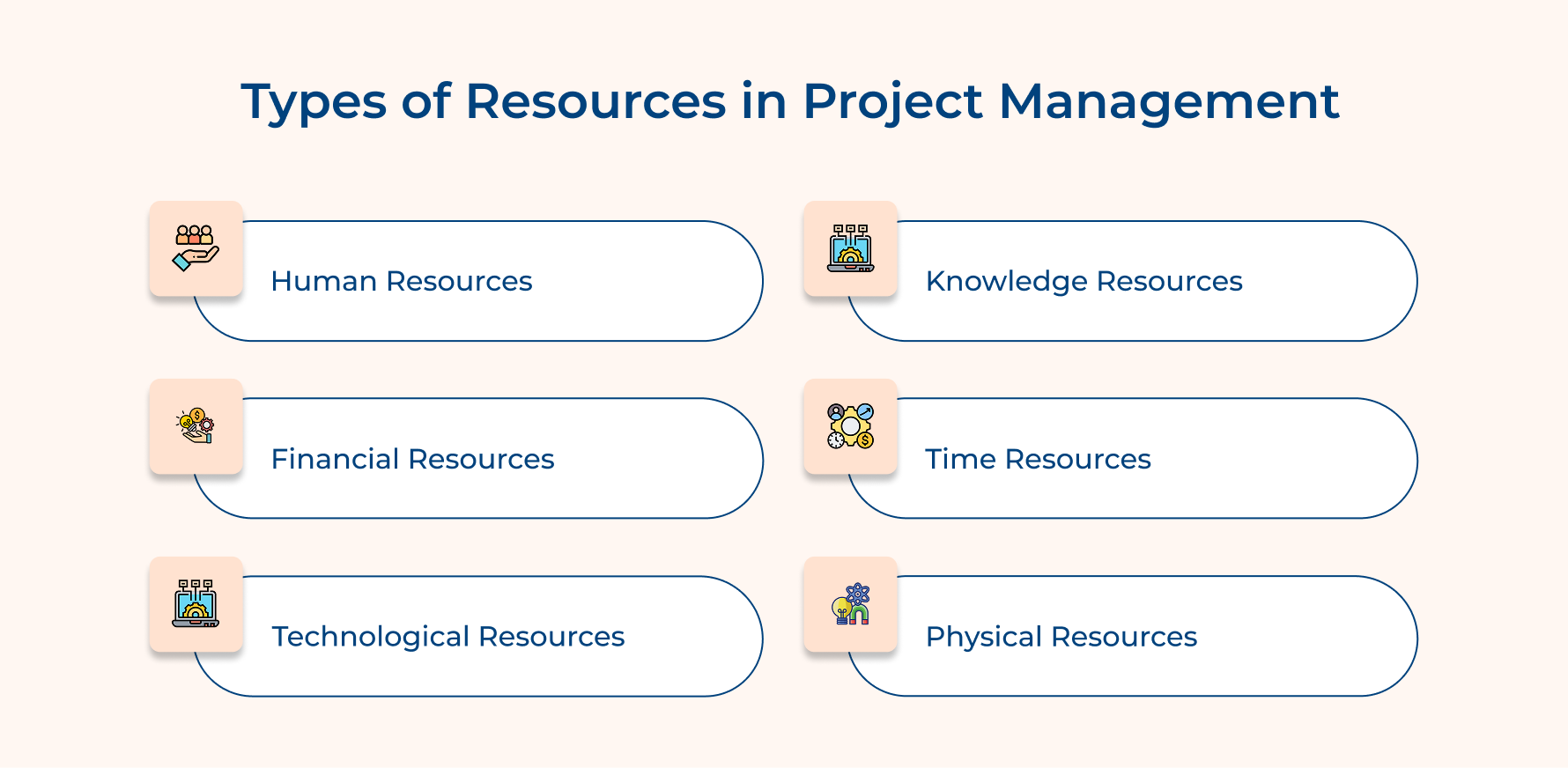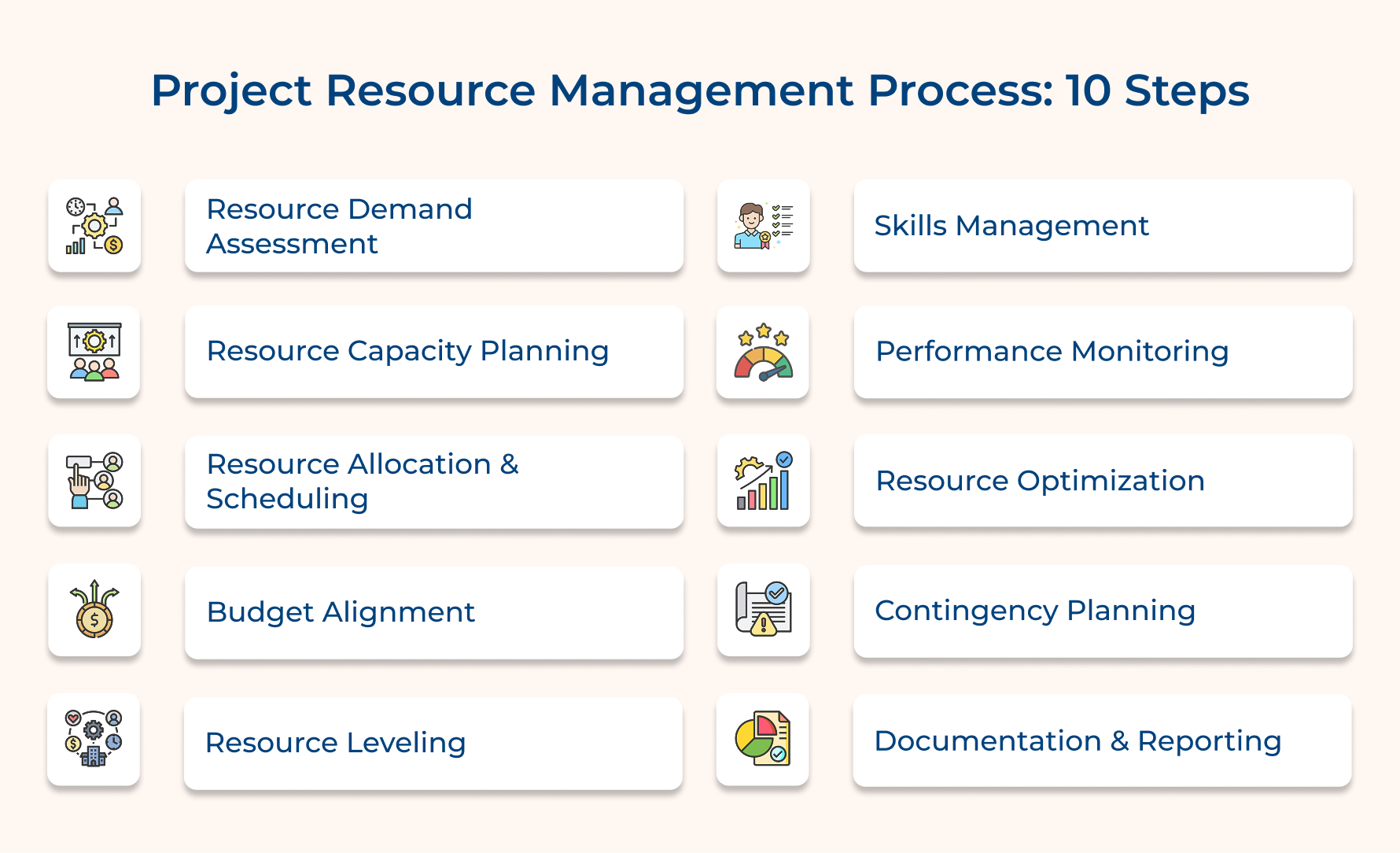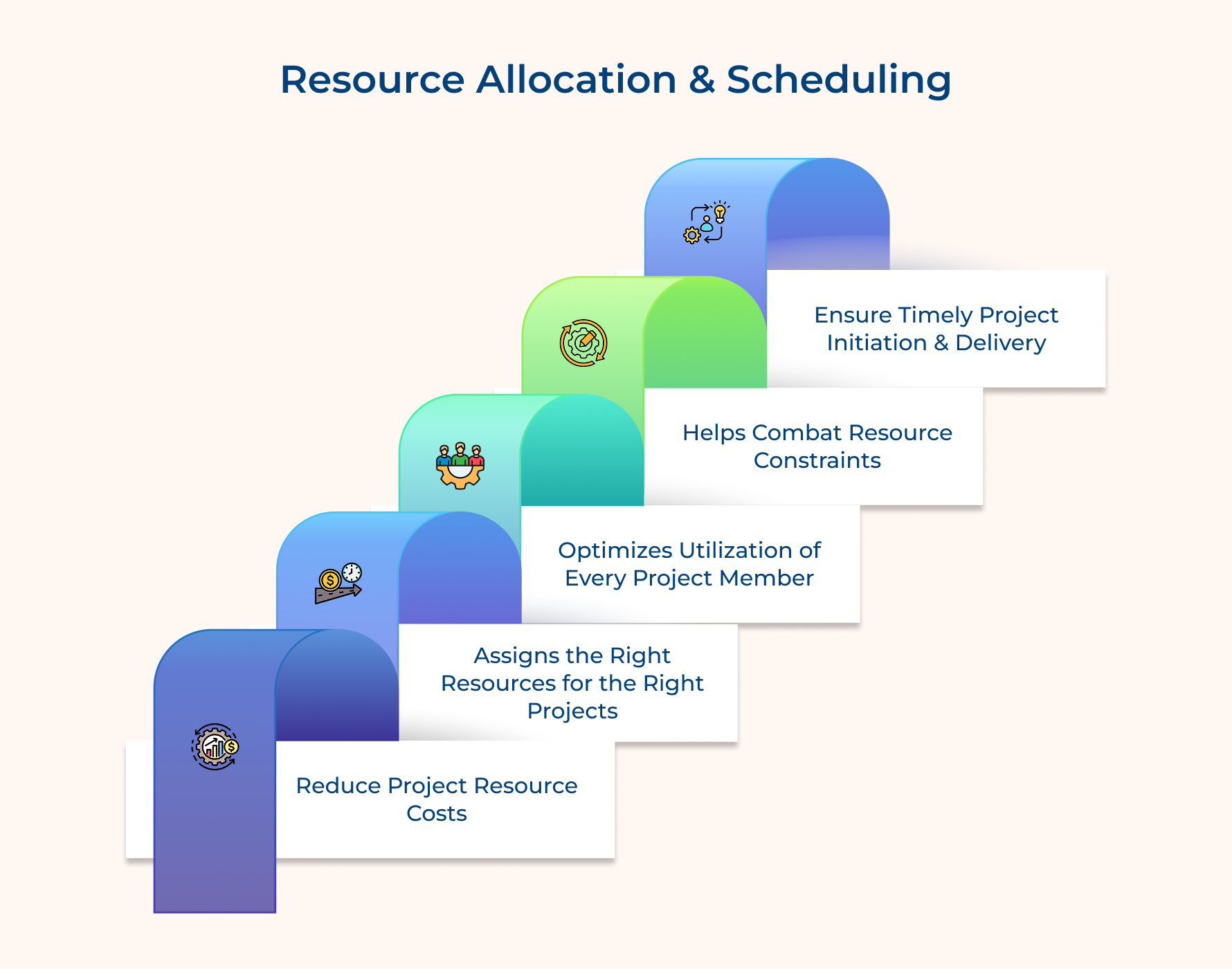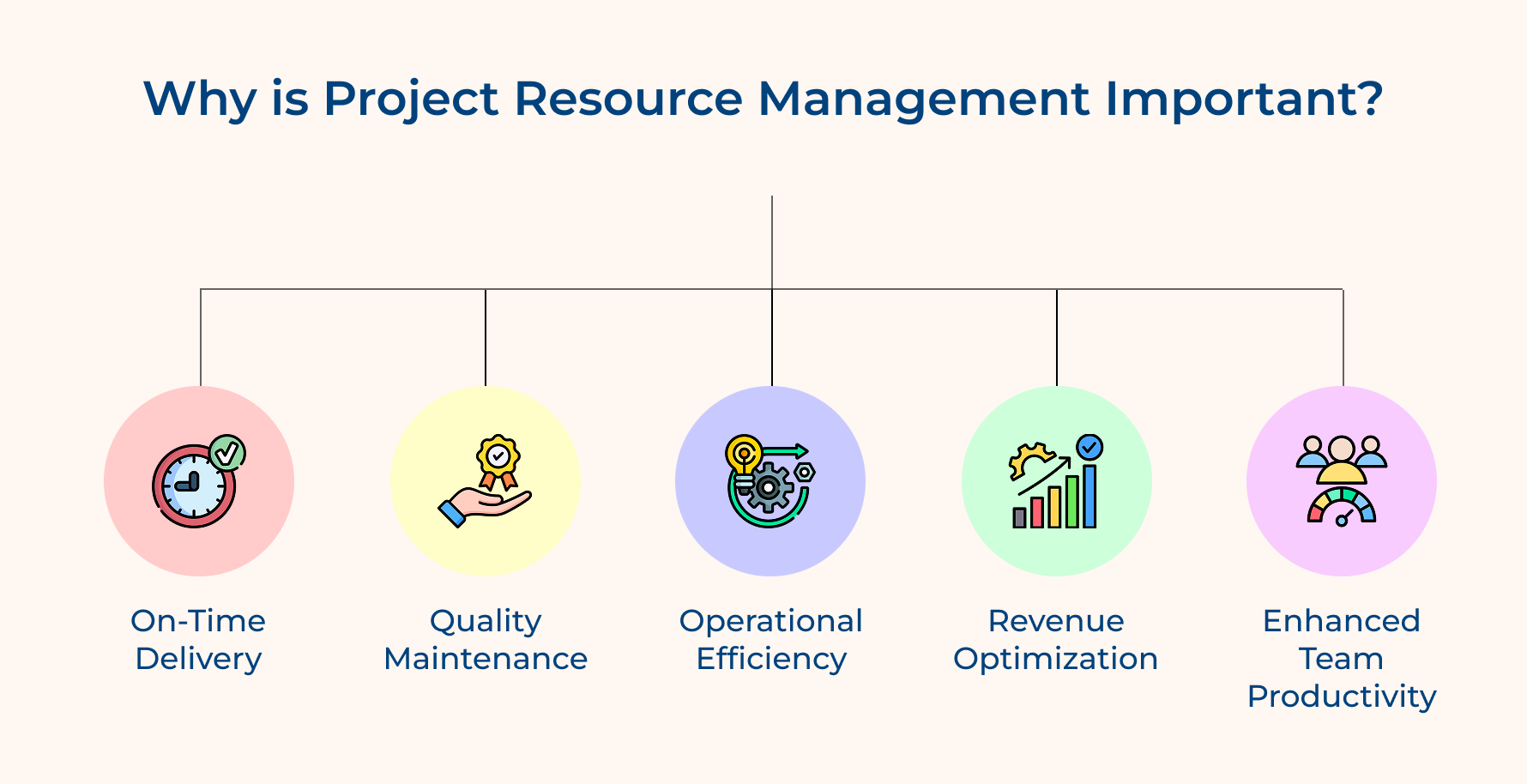10 Steps to Successful Project Resource Management
- What is Project Resource Management (PRM)?
- Types of Resources in Project Management
- 10 Steps To Successful Project Resource Management Process
- Why is Project Resource Management Important?
- Best Practices to Improve Project Resource Management
- Maximizing Project Efficiency Through Resource Planning
- FAQs about Project Resource Management

Key Highlights:
- Proper demand assessment matches skills to tasks, avoiding shortages and optimizing team output.
- Project resource management helps prioritize high-impact projects and review resource allocation to ensure smooth execution.
- Track resource utilization, monitor KPIs, and adjust to ensure projects stay on schedule as well as meet client expectations.
If you think that effective Project Resource Management (PRM) is not a challenge, then think again!
Many organizations experience issues like the overallocation of resources, missed deadlines, and project inefficiencies. It trickles down to dire consequences such as delays and even budget overruns.
A growing company experiencing more complex issues is a given fact. However, it all depends on how you ensure to keep the project plan on track and align the project requirements with your ultimate goals.
A structured approach to PRM helps optimize resource utilization, balance workloads, and improve overall project outcomes.
Let’s explore how adopting best practices in resource management can address these challenges and ensure smoother, more successful project execution.
What is Project Resource Management (PRM)?
Project Resource Management (PRM) refers to the process of planning, organizing, and managing resources effectively throughout the lifecycle of a project. The resources can be human, financial, physical as well as informational.
PRM aims to ensure that the right resources are available at the right time and are utilized optimally to achieve project objectives.
Effective resource management ensures that a project has the necessary resources to meet its goals while avoiding resource shortages, over-utilization, or underutilization. One of the resource management techniques is resource smoothing, which optimizes resources while also completing the project on time.
Key objectives:
- Resource optimization: Maximize the efficient use of all available resources while minimizing waste and idle time to achieve optimal return on investment.
- Capacity planning: Ensure sufficient resource availability at the right time and place by accurately forecasting while planning resource requirements throughout the project lifecycle.
- Cost control: Manage allocation of resources to stay within budget constraints while maintaining project quality standards and meeting deliverable requirements.
- Performance enhancement: Improve overall project performance by matching the right resources with the right tasks, considering skills, experience, and availability.
Types of Resources in Project Management
When it comes to managing a project, there’s a variety of resources that come into play, each playing a key role in ensuring that everything runs smoothly.
Human resources: This is all about the people—project managers, team members, employees, contractors, and consultants. They bring their skills as well as time to the table. Managing them requires finding the right balance between their capabilities and availability and making sure workloads are distributed evenly across tasks.
Financial resources: A project’s budget, client retainers, and any investment capital are what drive its execution. Direct costs like software licenses or indirect costs such as overhead are critical to track, especially for agencies aiming to deliver value while maintaining profitability.
Technological resources: Digital tools and software have become indispensable. From design programs to project management platforms, these tech tools help teams stay organized and get work done. Agencies also rely on testing tools, collaboration platforms, and development environments to deliver high-quality results.
Knowledge resources: The knowledge is about everything from documented processes and best practices to templates as well as frameworks. The accumulated knowledge from previous projects is a real asset, as it helps agencies streamline delivery, maintain quality, and use past experiences to benefit clients.
Time resources: Time is a precious resource in the professional services world. Managing billable hours, sticking to project time frames, all while keeping an eye on delivery schedules, ensures both profitability and that deadlines are met without a hitch.
Physical resources: Even in our digital age, physical resources like office space, meeting rooms, and equipment are still important. These spaces build collaboration, provide room for client meetings, and support creative work, helping keep everything on track.
10 Steps To Successful Project Resource Management Process
Effective resource management is the backbone of any successful project. Here are 10 key steps that can help streamline the process and ensure your project runs smoothly from start to finish.
1. Resource Demand Assessment
Agencies often juggle multiple client projects at once, each with its own set of requirements and deadlines. To avoid scrambling for resources at the last minute, it’s crucial to accurately assess demand right from the start. This helps prevent resource shortages, ensures the right skills are matched to each task, and keeps the quality of the project intact.
For example, imagine an agency taking on a website redesign for a client with a tight deadline. The project manager would need to assess the scope, break down the deliverables, as well as identify exactly which skills—like web design, copywriting, and SEO—are required, along with how many hours each task will take. This information is then put into a resource requirement document, which maps out these needs across the project timeline.
The detailed planning feeds directly into capacity planning, helping the agency decide whether to hire additional staff or bring in freelancers for specific tasks.
Pro tip: Create standardized project scoping templates that include skill requirements and effort estimates for each deliverable. Also, hold a weekly resource forecasting meeting with project leads to stay ahead of any potential gaps or overlaps in availability.
Maintaining a skills matrix dashboard that tracks your team’s capabilities and availability ensures that you’re always ready to allocate the right people to the right tasks. By updating it monthly with new skills or certifications, you stay on top of your team’s ever-evolving strengths.
2. Resource Capacity Planning
Capacity planning ensures that agencies can meet client commitments while maintaining healthy utilization rates. It prevents burnout, optimizes resource allocation, and helps maintain profitability by balancing workloads across teams while identifying when to scale up or down.
Managers analyze available working hours, considering holidays, meetings, and non-billable time. They track utilization rates and bench time, using this data to make decisions about resource allocation, hiring needs, as well as project timelines.
How can you make it more effective? These quick tips can help!
- Set up a real-time capacity tracking system showing each team member’s allocation percentage and availability for the next 8-12 weeks
- Schedule monthly capacity review meetings to assess team utilization rates and adjust workload distribution accordingly
- Create buffer zones of 15-20% in capacity calculations to account for unexpected client requests and project changes
3. Resource Allocation & Scheduling
Proper Allocation of Resources ensures that the right people are working on the right projects at the right time, maximizing productivity, maintaining work quality, and ensuring client satisfaction. It also helps prevent team burnout as well as resource conflicts.
Project Managers Use Resource Management Tools
- Assign team members based on skills, availability, and project priorities.
- Create detailed schedules accounting for dependencies, constraints, and flexibility.
Example:
- In an advertising agency, scheduling involves coordinating with creative, media buying, and analytics teams to ensure tasks are completed on time.
- In a law firm, associates are assigned to specific cases, and senior partners are allocated time for review.
Resource Allocation Tips:
- Priority-based allocation system: High-impact client projects get first access to key resources, ensuring critical tasks are prioritized.
- Role-based backup plans: Ensure at least two people can handle critical tasks, reducing risks if a key team member is unavailable.
- Weekly allocation reviews: Adjust resource allocations regularly, taking project progress and changing client needs into account.
4. Budget Alignment
Budget alignment is key to making sure projects stay profitable while still delivering great value to clients. It helps agencies stay financially healthy, make smart decisions about where to invest in resources, and keep client expectations in check.
Track Resource Costs Against Budgets
- Keep an eye on billable hours and profitability to stay on top of how the project is performing.
- Use this info to make smart choices about staffing, rate cards, and even scope adjustments with clients.
Pro Tips for Keeping Your Budget on Track:
- Weekly budget tracking: Set up quick weekly reports to compare planned vs. actual resource costs for each project. It helps spot issues before they become big problems.
- Clear escalation protocols: Establish rules for flagging projects that are nearing their budget limits. Addressing it early can prevent surprises down the road.
- Flexible rate cards: Create standardized rate cards with flexibility built in. This way, you can easily adjust for different client tiers or project needs without a hitch.
5. Resource Leveling
Resource leveling is all about avoiding both work overload and underutilization, ensuring teams stay productive without burning out. It helps maintain a sustainable workload, keeps morale high, and ensures consistent quality across all client projects—while also maximizing billable hours.
Managers typically start by analyzing how work is distributed across the key team, looking for any patterns that show an imbalance. If some team members are overloaded or others have too little to do, they’ll adjust project timelines and redistribute tasks to create a more even workload.
Using resource management tools, they can easily spot these peaks and valleys in allocation, making adjustments where necessary to smooth things out as well as keep everything running on track.
What can you do for a smoother flow?
- Implement a traffic light system (Green/Yellow/Red) to monitor individual workload levels and set automatic alerts for over-allocation.
- Create floating resource pools with cross-trained team members who can support different departments during peak periods.
- Develop quarterly resource forecasting models that account for seasonal variations and planned leave.
6. Skills Management
Agencies need to maintain a competitive advantage through up-to-date skills. Proper skills management ensures teams can handle evolving client needs, new technologies, and industry trends while maintaining high-quality deliverables.
Organizations track team capabilities, identify training needs, and plan skill development initiatives. They maintain skills matrices and use them for project staffing, professional development planning as well as hiring decisions.
Create individual skill development plans tied to both current project needs and future agency growth areas. Schedule monthly “skill-share” sessions where team members can teach others about new tools or techniques. Maintain a digital skills database with certification tracking and automated reminders for renewals.
7. Performance Monitoring
Performance monitoring is key to ensuring project quality, client satisfaction, and team productivity. It helps spot issues early, allowing for proactive problem-solving and providing the data needed to improve continuously how resources are allocated.
For example, imagine an agency working on a brand campaign for a client. The team tracks key performance indicators (KPIs) like billable hours, project milestones, and client feedback. With performance dashboards, they can see how things are going in real time and adjust resource allocation if any red flags pop up.
Maybe they notice that one part of the campaign is lagging behind or that client feedback suggests a different approach—those insights help the team make quick, informed decisions to keep things on track.
8. Resource Optimization
Resource optimization maximizes agency profitability and efficiency. It ensures the best use of available talent, reduces waste, and helps maintain competitive pricing while delivering high-quality work.
Managers continuously analyze resource allocation patterns, identify inefficiencies, and make adjustments. They balance cost considerations with quality requirements and client expectations.
Here are some quick tips for you to consider:
- Develop a resource scoring system that considers both utilization and effectiveness in project delivery.
- Create monthly optimization reviews focusing on identifying and eliminating resource waste.
- Implement an AI-powered resource suggestion system for optimal team composition.
9. Contingency Planning
Agencies need contingency plans for unexpected disruptions like resource shortages or sudden client demands. By building networks of trusted freelancers and creating flexible resource pools, teams can stay prepared for any scenario.
Let’s understand through an example: having a bench of pre-vetted freelancers for key roles ensures quick replacements, while handover documents for critical accounts allow smooth transitions if a team member is unavailable.
Adding to it, developing rapid response protocols helps the team address common resource emergencies quickly, maintaining business continuity and client satisfaction even when things don’t go as planned.
10. Documentation & Reporting
Good documentation ensures transparency, enables informed decision-making, and maintains organizational knowledge. It supports resource planning, performance evaluation, and process improvement.
Teams create as well as maintain resource allocation records, utilization reports, and performance metrics. They use this documentation for planning, auditing, and improving resource management processes.
Actionable tips to consider:
- Create standardized templates for all resource-related documentation with clear updated schedules.
- Implement automated reporting systems that generate daily resource snapshots and weekly trend analyses.
- Maintain a central knowledge base for resource management best practices and lessons learned.
Why is Project Resource Management Important?
Resource management in project management is all about making sure you have the right people, skills, and tools when you need them. Let’s understand how this helps overall growth.
On-Time Delivery
Managing resources properly ensures the right people, equipment, and materials are available when you need them, preventing delays. With smart planning, you can avoid shortages and scheduling conflicts, making sure projects are completed on time.
Quality Maintenance
Resource management helps assign tasks to the right people with the right skills and tools. This leads to better quality work, as the project gets done with the necessary expertise and resources.
Operational Efficiency
Good resource management keeps workflows smooth and cuts down on unnecessary admin work. It helps organizations predict future needs, make hiring plans, and make informed decisions on project timelines, all of which streamline operations.
Revenue Optimization
The strategic allocation of resources maximizes billable hours and boosts profitability. Understanding resource capacity as well as availability allows agencies to take on the right projects, set competitive prices, and make sure resources are working to generate the most revenue.
Enhanced Team Productivity
When resources are well-managed, teams can collaborate better. Everyone knows what’s available and when, which keeps things running efficiently while helping projects flow more smoothly.
Best Practices to Improve Project Resource Management
Improving project resource management is key to keeping everything on track. Here are some best practices that can help optimize how resources are allocated and utilized.
Leverage Resource Management Tools
Use advanced project management as well as resource scheduling software to streamline the planning, allocation, and tracking of resources.
Tools like Kooper, Smartsheet, Monday.com, or resource management-specific platforms (e.g., 10,000ft or Float) help track availability, prevent overallocation, and ensure efficient resource distribution. These tools also provide visibility into resource utilization, helping managers identify potential bottlenecks or inefficiencies.
Track Resource Utilization and Performance
Regularly monitor how resources are being utilized throughout the project. For agencies, this might involve reviewing the time spent on creative tasks or the performance of digital campaigns.
For professional firms, tracking billable hours, project milestones, and consultant performance is key. Establish KPIs (Key Performance Indicators) to measure how effectively resources are being used and make adjustments as needed.
Build Cross-Functional Collaboration
In both agencies and professional firms, resources often come from different departments or areas of expertise.
Encourage collaboration between teams (e.g., creative, technical, client services in an agency; or legal, consulting, and support staff in a professional firm) to ensure that everyone is aligned on project goals, timelines, as well as resource needs.
Ensure Flexibility in Resource Allocation
Resource needs can change throughout a project due to scope changes, client requests, or unforeseen challenges. Build flexibility into your resource management approach by creating contingency plans and being prepared to reallocate resources when necessary.
For instance, if a client requests an urgent revision, ensure that team members can be reassigned to accommodate the new work without disrupting the overall schedule.
Invest in Resource Development and Training
Continually develop your team’s skills to ensure they remain capable of handling the evolving needs of projects. In agencies, this could involve training creative staff on new design tools or digital marketing platforms.
In professional firms, it may include certifications for consultants or training on emerging legal technologies. A well-trained team can be more efficient and adaptable when it comes to managing resources.
Analyze Post-Project Resource Performance
After completing a project, take time to analyze how resources were managed throughout its lifecycle.
Identify what worked well and where improvements can be made. This analysis should cover resource utilization rates, skill matchups, productivity, and any challenges faced. By doing this, agencies and professional firms can refine their resource management processes for future projects.
Prioritize Client-Centric Resource Management
In agencies and professional firms, client satisfaction is paramount. Resource management should always prioritize the delivery of high-quality work on time while being mindful of client needs and expectations.
Establish clear client communication regarding project timelines, resource constraints, and potential challenges to manage expectations as well as avoid last-minute resource strain.
Maximizing Project Efficiency Through Resource Planning
Project resource management serves as the backbone of successful project delivery. It ensures optimal utilization of human capital, equipment, and materials while preventing bottlenecks as well as resource conflicts. Effective resource management directly impacts project timelines, budget adherence, and team morale, making it crucial for sustainable project success.
The achievement of effective resource management demands a systematic approach that combines strategic planning, continuous monitoring, and agile adaptation. Organizations must implement robust resource planning tools and maintain open communication channels. Regular audits, performance tracking, and data-driven decision-making enable teams to optimize resource utilization while maintaining project quality while meeting stakeholder expectations.
Limit time — not creativity
Everything you need for customer support, marketing & sales.
Neeti Singh is a passionate content writer at Kooper, where he transforms complex concepts into clear, engaging and actionable content. With a keen eye for detail and a love for technology, Tushar Joshi crafts blog posts, guides and articles that help readers navigate the fast-evolving world of software solutions.



